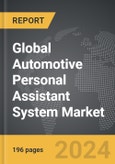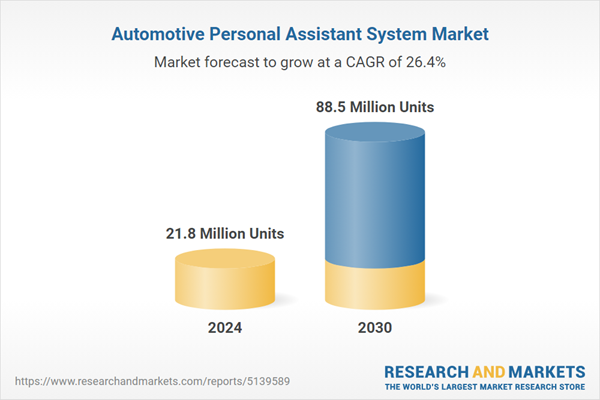Global Automotive Personal Assistant System Market - Key Trends and Drivers Summarized
How Do Automotive Personal Assistant Systems Work?
Automotive Personal Assistant Systems (APAS) are advanced software platforms integrated into vehicles, designed to enhance the driving experience by offering a seamless interface between the driver, the car, and the digital world. These systems typically combine natural language processing (NLP), artificial intelligence (AI), and machine learning (ML) to provide voice-activated services and smart automation. They operate by continuously learning from the user's behavior, preferences, and routines, allowing them to predict needs and offer personalized recommendations. For instance, an APAS can suggest optimal driving routes based on real-time traffic conditions, recommend nearby restaurants according to the driver's taste, or even adjust the car's climate control settings automatically. This technology integrates various components, including in-car infotainment, navigation systems, and smart home connectivity, transforming the vehicle into an intelligent hub that responds intuitively to the driver's voice commands and actions.Why Is There a Growing Demand for These Systems?
The demand for Automotive Personal Assistant Systems has surged due to several converging factors. Firstly, there is an increasing consumer expectation for connected and intelligent vehicle experiences, driven by the rapid advancement of smartphones and smart home devices. As consumers become more accustomed to the convenience and functionality of voice-activated assistants like Amazon's Alexa or Google Assistant, they naturally seek similar features in their vehicles. Secondly, the automotive industry's shift towards electric and autonomous vehicles has accelerated the adoption of APAS. These vehicles, by design, require more sophisticated software and interface systems to manage their complex operations and ensure a smooth, autonomous driving experience. Additionally, the integration of APAS in vehicles is also propelled by the rising focus on driver safety and distraction minimization, as these systems allow drivers to access information, control vehicle functions, and communicate hands-free, reducing the need for manual interaction with in-car systems.What Are the Key Features and Capabilities of Modern APAS?
Modern Automotive Personal Assistant Systems offer a wide range of features that cater to both convenience and safety. Beyond basic voice control and navigation assistance, these systems are now equipped with advanced functionalities such as emotional recognition, which gauges the driver's mood and adjusts in-car settings accordingly. For instance, if the system detects signs of stress in the driver's voice, it might suggest playing calming music or recommend a break. Furthermore, APAS can now interface with smart home systems, allowing drivers to control home devices like thermostats, lighting, or security systems directly from their car. The integration of AI has also enabled these systems to provide predictive maintenance alerts, where the system can analyze vehicle data to predict when a component might fail and notify the driver to service the car before any issues arise. These capabilities not only enhance the driving experience but also contribute to vehicle longevity and improved safety on the road.What Is Driving the Growth of the Automotive Personal Assistant Systems Market?
The growth in the Automotive Personal Assistant Systems market is driven by several factors that reflect both technological advancements and evolving consumer behaviors. Firstly, the proliferation of AI and machine learning technologies has significantly improved the capabilities and accuracy of APAS, making them more attractive to consumers and automakers alike. Secondly, there is a growing trend towards vehicle electrification and automation, which necessitates more sophisticated onboard systems to manage these new functionalities. As electric and autonomous vehicles become more prevalent, the demand for integrated systems like APAS that can offer seamless and intuitive user experiences will continue to rise. Thirdly, the increasing emphasis on in-car safety and reducing driver distractions is pushing automakers to incorporate APAS as a standard feature in new vehicles. Additionally, the expanding connected car ecosystem, which allows vehicles to communicate with other devices and systems, is further propelling the market, as consumers expect their vehicles to be an extension of their digital lives. Finally, the global push towards smart cities and IoT integration is also a significant growth driver, as it creates an environment where vehicles equipped with APAS can interact more effectively with their surroundings, offering a more connected and efficient driving experience.Report Scope
The report analyzes the Automotive Personal Assistant System market, presented in terms of market value (USD). The analysis covers the key segments and geographic regions outlined below.- Segments: Segment (Automotive Personal Assistant System).
- Geographic Regions/Countries: World; United States; Canada; Japan; China; Europe (France; Germany; Italy; United Kingdom; Spain; Russia; and Rest of Europe); Asia-Pacific (Australia; India; South Korea; and Rest of Asia-Pacific); Latin America (Argentina; Brazil; Mexico; and Rest of Latin America); Middle East (Iran; Israel; Saudi Arabia; United Arab Emirates; and Rest of Middle East); and Africa.
- Regional Analysis: Gain insights into the U.S. market, valued at 5.4 Million Units in 2024, and China, forecasted to grow at an impressive 32.7% CAGR to reach 25.2 Million Units by 2030. Discover growth trends in other key regions, including Japan, Canada, Germany, and the Asia-Pacific.
Why You Should Buy This Report:
- Detailed Market Analysis: Access a thorough analysis of the Global Automotive Personal Assistant System Market, covering all major geographic regions and market segments.
- Competitive Insights: Get an overview of the competitive landscape, including the market presence of major players across different geographies.
- Future Trends and Drivers: Understand the key trends and drivers shaping the future of the Global Automotive Personal Assistant System Market.
- Actionable Insights: Benefit from actionable insights that can help you identify new revenue opportunities and make strategic business decisions.
Key Questions Answered:
- How is the Global Automotive Personal Assistant System Market expected to evolve by 2030?
- What are the main drivers and restraints affecting the market?
- Which market segments will grow the most over the forecast period?
- How will market shares for different regions and segments change by 2030?
- Who are the leading players in the market, and what are their prospects?
Report Features:
- Comprehensive Market Data: Independent analysis of annual sales and market forecasts in US$ Million from 2024 to 2030.
- In-Depth Regional Analysis: Detailed insights into key markets, including the U.S., China, Japan, Canada, Europe, Asia-Pacific, Latin America, Middle East, and Africa.
- Company Profiles: Coverage of players such as Axiomtek Co., Ltd., Bendix Commercial Vehicles Systems LLC, BMW Group (Bayerische Motoren Werke AG), Mobileye Vision Technologies Ltd., Nissan Motor Co., Ltd. and more.
- Complimentary Updates: Receive free report updates for one year to keep you informed of the latest market developments.
Some of the 46 companies featured in this Automotive Personal Assistant System market report include:
- Axiomtek Co., Ltd.
- Bendix Commercial Vehicles Systems LLC
- BMW Group (Bayerische Motoren Werke AG)
- Mobileye Vision Technologies Ltd.
- Nissan Motor Co., Ltd.
- Nuance Communications, Inc.
- Robert Bosch GmbH
- Tata Motors Ltd.
- Vbox
- Wipro Ltd.
This edition integrates the latest global trade and economic shifts into comprehensive market analysis. Key updates include:
- Tariff and Trade Impact: Insights into global tariff negotiations across 180+ countries, with analysis of supply chain turbulence, sourcing disruptions, and geographic realignment. Special focus on 2025 as a pivotal year for trade tensions, including updated perspectives on the Trump-era tariffs.
- Adjusted Forecasts and Analytics: Revised global and regional market forecasts through 2030, incorporating tariff effects, economic uncertainty, and structural changes in globalization. Includes historical analysis from 2015 to 2023.
- Strategic Market Dynamics: Evaluation of revised market prospects, regional outlooks, and key economic indicators such as population and urbanization trends.
- Innovation & Technology Trends: Latest developments in product and process innovation, emerging technologies, and key industry drivers shaping the competitive landscape.
- Competitive Intelligence: Updated global market share estimates for 2025, competitive positioning of major players (Strong/Active/Niche/Trivial), and refined focus on leading global brands and core players.
- Expert Insight & Commentary: Strategic analysis from economists, trade experts, and domain specialists to contextualize market shifts and identify emerging opportunities.
Table of Contents
Companies Mentioned (Partial List)
A selection of companies mentioned in this report includes, but is not limited to:
- Axiomtek Co., Ltd.
- Bendix Commercial Vehicles Systems LLC
- BMW Group (Bayerische Motoren Werke AG)
- Mobileye Vision Technologies Ltd.
- Nissan Motor Co., Ltd.
- Nuance Communications, Inc.
- Robert Bosch GmbH
- Tata Motors Ltd.
- Vbox
- Wipro Ltd.
Table Information
| Report Attribute | Details |
|---|---|
| No. of Pages | 196 |
| Published | December 2025 |
| Forecast Period | 2024 - 2030 |
| Estimated Market Value in 2024 | 21.8 Million Units |
| Forecasted Market Value by 2030 | 88.5 Million Units |
| Compound Annual Growth Rate | 26.4% |
| Regions Covered | Global |









